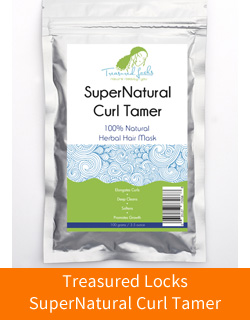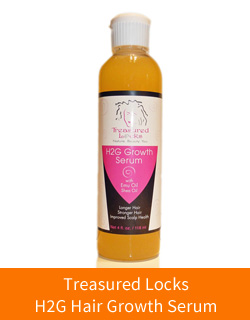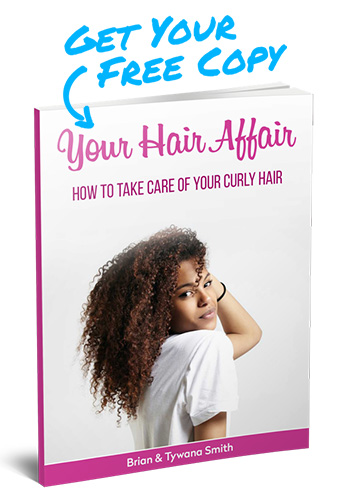
Over the course of the last few years, Black women choosing to wear their natural hair has gone from a rarity to a mainstream movement. Every day more and more women ask us about the best way to make the transition from permed or relaxed hair to their natural tresses. Making the transition from chemically treated hair should be an exciting time for you.
But, there are still those who will oppose your choice. And, there is the fear of the unknown as many women literally don't remember far enough back to know what their natural hair texture is like. "Will I be able to maintain my hair in its natural state?" is a common question. You might find you face objections from family members, husband, boyfriend or even in the workplace.
Unfortunately, we can't help with those societal pressures other than to help support you and to let you know you are not alone. But, we can give you some pointers about what to expect as you begin on your journey. We can guide you through the unknown and help make the transition go as easy as possible.
What to Expect When Transitioning to Natural Hair
One of the biggest problems women face when making the transition is the problem of losing length. Many Black women struggle all their lives to grow their hair long. Women with chemically treated hair often experience unexplained breakage, particulary around the nape of the neck. Giving up any length at all is difficult for these women.
Sometimes women will ask us how they can keep their permed hair's length and just make the relaxed hair natural again. The answer is it is not possible. Once hair has been chemically relaxed, that particular piece of the hair shaft is forever altered in its texture. The new growth (from the scalp) will be natural hair. But, the new growth will always be attached to the chemically treated hair until the hair falls out at the root.
A big mistake some women make it so simply try to grow the natural hair in and keep the permed hair without a real strategy for transitioning. This will not only look bad as you have the natural roots and the straight remainder of the hair, it can lead to excessive breakage. The part of the hair where the natural hair joins the permed hair tends to be weak and the hair can easily break there.
So, in making the transition, there are two choices. You can keep the permed hair at the end of the natural hair that is coming in and try to minimize the breakage. Or you can go "cold turkey" and cut the relaxed hair off.
Gentle care of your hair during the transition and wearing styles that minimize how much combing you will have to do, can minimize the breakage you will experience. How much breakage you will experience is going to be dependent on a number of factors including your hair type and how well you maintain your hair during the process. SuperNatural Curl Tamer actually softens the new growth, strengthens the hair and minimizes breakage during the transition.
How to Make the Transition to Natural Hair
There are really only a few ways to accomplish the transition from chemically treated to natural hair. The most simple and fastest way is to simply chop off the permed hair all at once.
- Cut off the relaxed hair- This is the fastest and boldest way to make the transition. Insteading of going in for that touch up at six or either weeks, you can simply visit your salon and have your stylist cut off all of the permed hair. Depending on how much new growth you have, you will be fairly limited in styling options. Some women opt to go with a Tweeny Weeny Afro (TWA). Or, two strand twists or comb twists (coil twists) can be pulled off with just about any length hair.
- Braids and/or extensions- One way to maintain your length while you transition is to have hair (human or artificial) braided into your own hair. This will mask the difference in texture between your new growth and the permed hair and give you length while you are growing in enough natural hair to feel comfortable making the "big chop".
- SisterlocksTM- We think SisterLocks are a great way to make the transition be started with one and one half inches of new growth at the scalp. SisterLocks use your own natural hair and can be started leaving the relaxed hair in place. Gradually, the relaxed hair is trimmed away. SisterLocks are similar to traditional dread locks. But, they look more like micro braids or very small twists. They leave you with your length and a lot of styling options. For more information (including pictures) go to https://www.sisterlocks.com
- Other Transition Styles- see below for more ideas of styles to wear while making the transition from relaxed to natural hair.
If you choose to keep your relaxed hair while you are growing in your natural hair, please be aware that your hair is more fragile than normal while making the switch.
To protect your hair you should:
- minimize the amount of heat you are using to style it,
- minimize how much you have to handle (comb) it,
- and make sure you keep it very well moisturized.
- We recommend the use of a silk cap or scarf at night (the G-wrap works great). This will prevent your pillowcase from wicking moisture away from your hair and reduce breakage from the friction of rubbing your head on the pillow.
How Not to Make the Transition to Natural Hair
While making the transition to natural hair, there is are some things you will want to avoid. Trying to "revert" the relaxed hair with chemicals might make it frizzy. But, it's never a good idea to pile one chemical treament on top of another. These products will not make your hair natural again.
Some women will try pressing out the natural hair to make it look like the permed hair. That seems like a good idea. But, it's putting stress on your hair and may cause breakage. Also excessive pressing of natural hair can end up permanently straightening it, which in turn delays the transition you're trying to make as you've now got three textures of hair- hair chemically straightened, hair permanently straightened by heat and natural hair.
Transitioning to natural hair in other ways, like pressing the natural hair as it grows in underneath the relaxed hair, are going to make your hair prone to breakage and can damage the natural hair you're trying to grow in.
Products that claim to revert permed hair might make it frizzy, but are not going to really make it natural. You do not want to put chemicals on top of chemicals in your hair. You will only end up damaging the hair and get even more breakage than you would experience otherwise.
While transitioning, try to find a style that will incorporate the new growth coming in with the relaxed hair- something like twists or braids.
Finding a Natural Hair Transition Style
Finding a way to style your hair while making the transition may be the biggest challenge you will face when it comes to making the switch. That is beside the snide comments you might get from friends and family. Trying to figure out how to style your hair when it's extremely short may be something you've never done before. Or trying to figure out how style your hair when the roots are kinky/curly and the rest of the it is straight will be new for most people. There are several options.
Here are a few:
- Teeny Weeny Afro- just bite the bullet and be done with it. Do the "big chop" and rock a small afro for a while.
- Braids or SisterLocks- as we mentioned earlier, you can either choose to do extensions, braiding additional hair into your relaxed hair. Alternatively, you can use SisterLocks which can be started with as little as 1-1/2" of new growth at the scalp and the rest of the hair still relaxed.

- Two Strand Twists or Comb Twists- This is very simple yet effective you can wear for years. It probably won't work well with relaxed hair as the relaxed hair won't hold the style. But, if you decide to cut your hair, you can use part your hair into sections like you would do if you were going to plait it.
Then, either twist a strand a comb or, using your fingers, take two strands and twist them around each other. This style can be worn for a week or two before you have to re-style. But, be careful. If you wear your hair this way too long before restyling, you hair will beging to lock.
Make sure you take the style down every once in a while. An added bonus to wearing two-strand twists is the "twist out" style. A few days before you're ready to restyle your hair, just remove the twists and you'll find your hair has natural crinkles in it. - Straw Set (see below)- this is a nice styling option if you want to hang onto your relaxed hair. The tight curls hide the different textures between your roots and ends much less noticeable.
- Crinkle Set or Twist Out- some women will plait or twist their hair with no intention of wearing it out of the house in that style. I used to do this when my hair was permed. When my hair was wet, I'd plait it in very large plaits and then remove them after my hair was dry. A setting gel will help hold the look. This is simple and cute look.
- Flat Twists- basically the same as cornrows. The difference is you use two strands of hair instead of three.For other styling ideas visit
How To Do a Straw Set
As your new growth approaches an inch in length, you'll mostly like start to notice the texture difference between the natural hair and the permed hair. The straw set style will protect your hair by reducing the strain where the hair is most vulnerable. Instead of having to use a comb in your hair, you can just "finger comb" it. This style might take some time to perfect. But, once you get practice, it'll be easier and faster for you.
You will need:
- A pack of plastic drinking straws
- For slightly larger and looser curls, use small perm rods- you can get these at most beauty supply stores like Sally's.
- End papers
- Bobby pins
- Black Earth Crinkles & Curls or other setting lotion (make sure it doesn't contain ethyl or metyl alcohol)
- Light hair oil
- Wash your hair as normal with shampoo and conditioner. Dry lightly with a towel.
- Part you hair into one-quarter to one-half inch square sections.
- Place end papers on to ends of your hair.
- Roll your hair, wrapping it around the straw or perm rods. Hold it onto the end with a bobby pin.
- Repeat steps 2-4 until you have rolled up all of your hair.
- Gently dry hair under a hooded dryer.
- Gently remove the straws and separate the curls.
- Spray with a light oil and continue to spray with oil on a daily basis.
How To Do Flat Twists
You will need:
- Comb
- Black Earth Crinkles & Curls or other setting lotion (preferably one without ethyl or methyl alcohol)
- Bobby pins
- Wash your hair as normal with shampoo and conditioner. Dry lightly with a towel.
- Part your hair using a rat tail comb. It's important to make the parts nice and straight.
- Use a styling gel to help keep the hair from frizzing.
- Separate the section into 2 strands at the hairline.
- Wind one strand over the other, picking up hair as you move down the section.
- Secure the twist with a bobby pin placed parallel to and underneath the twist.
- You can either twist right to the back of your head or leave hair out at the ends and roller set or straw set.
How To Do the Twist Out Look
You will need:
- Setting lotion (Treasured Locks Locks of Curls Pomade & Gel are perfect for this)
- Hair Oil (any good hair oil will do- Treasured Locks H2G Hair Growth Serum, Hair & Scalp Elixir are great)
- Wash your hair as normal with shampoo and conditioner. Dry lightly with a towel.
- Add oil
- Plait or twist the hair while adding the setting lotion.
- If you want, you can wear the twists for a few days.
- Remove the plaits or twists. Gently fluff the hair with your fingers and wear crinkled for a few days.
- Either wear a cap at night or re-plait to maintain the style
Like this article? Share it!






